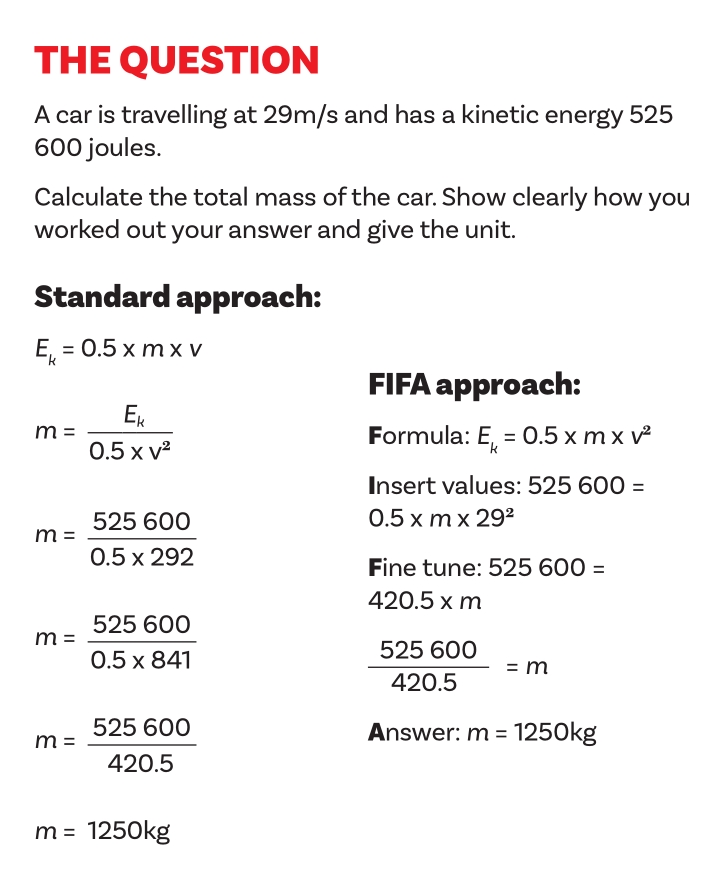GCSE Physics – How multistep calculations can improve students’ exam scores

Gethyn Jones explains how a simple four-letter mnemonic can help your students make short work of GCSE physics calculations…

- by Gethyn Jones

Is your physics department improvement plan barking up the wrong tree? If it includes such hallowed, yet shop-worn phrases as ‘Improve six-marker extended writing answers’ then it may well be.
In the latest specifications for both GCSE physics and the physics sections of GCSE combined science, 40% of the marks are for calculation questions.
Statistically, physics students are twice as likely to be asked to complete a multistep calculation for six marks than they are to write an extended answer in prose.
But how should we support our students? How do you move from a situation where the majority of students don’t even attempt to answer the simplest calculation exam questions, never mind the more challenging multistep ones?
We’ve found ‘FIFA’ to be an invaluable tool for giving students the confidence to begin making incremental progress, which over time can lead to significant improvements.
What is FIFA? It’s a simple mnemonic that we encourage our students to use for every calculation, standing for ‘Formula’; ‘Insert values’; ‘Fine-tune’ (a deliberately vague term that occasionally equates to ‘rearrange’); and ‘Answer’.
Let’s illustrate its use by considering a typical 5-mark physics question – one which, prior to the FIFA initiative, the majority of our students wouldn’t have touched with a barge pole:
‘A car is travelling at 29m/s and has a kinetic energy of 525 600 joules. Calculate the total mass of the car. Show clearly how you worked out your answer and give the unit.’

Step 1 | Write down the formula
The required formula here, of course, is the kinetic energy equation: Ek = 0.5 x m x v².
Higher paper candidates will have to recall this from memory. One argument which helped convince our students to memorise the 23 equations for GCSE physics was an analysis of a previous paper, which showed how a candidate who answered only the calculation questions correctly while leaving every other question blank would still have passed with a high grade 5. Calculations really can make or break a student’s success in GCSE physics and science.
Many mark schemes will award a mark for correct recall of the appropriate equation. Even if our students did nothing else beyond this, they would have scored 1/5. This is worth emphasising, as some students can be paralysed by their desire for perfection – ‘I’m not going to get any marks for this, so what’s the point?’
Replying with, “But you’ll get at least one mark, so…why not?” will be a surprisingly powerful encouragement to many students (even if they won’t admit it out loud).
Step 2 | Insert the values
Next, students extract the numerical values from the question. For this example, the second line that students write would be 525 600 = 0.5 x m x 292. This would gain a mark on many mark schemes, provided the correct values had been substituted into the correct relative positions. With the two lines they’ve written so far, our students will have scored 2/5, even if they make no further attempts at the question.
At this point, many teachers would encourage students to circle, highlight or colour-code the numerical values in the question. I’m agnostic on that, because such a process ‘butters no parsnips’ – that is, gains no marks.
I tend to view it more as a displacement activity than a useful and effective action, but if students enjoy the colour coding, then I’ve no objections – providing they gain that second mark.
Step 3 | Fine tune
The term ‘fine tune’ was partly chosen for its ambiguity. Essentially, what we mean here is ‘Do what you gotta do.’ Sometimes that might mean ‘rearrange’; in other instances, it might mean ‘convert units’ (such as kilojoules to joules). Occasionally it will mean ‘simplify!’
(Incidentally, we found that the concept of ‘tuning’ and ‘fine-tuning’ a radio set had to demonstrated to a generation of students more used to digital, rather than analogue entertainment!)
Back in step 2 we left our calculation answer as 525 600 = 0.5 x m x 292. The third line of our calculation should therefore be 525 600 = m x 420.5, since 0.5 x 29² is 420.5. The students are now encouraged to work incrementally and sequentially, sub-step by sub-step, to complete the fine-tuning stage.
When I first started using the FIFA system, it was strange to discover that students who’d normally run screaming from the room if asked to rearrange the simplest three-term equation can easily take almost identical problems in their stride – but only when the symbols have been replaced with numbers…
The next (and in this case, final) sub-step is to rearrange (line 4): 525 600 / 420.5 = m.
Step 4 | Answer
The fourth and final step of FIFA is to calculate the final answer and state the unit. In this case, the fifth and final line of the answer will be m = 1250kg which would gain the full 5/5 marks.
The correct final answer and unit on its own would also get 5/5 marks, of course, but the point of the FIFA system is to help students gain incremental marks along the way. It makes climbing what, to many students, seems like a very steep hill more manageable, as even a partially correct response will result in a significant confidence boost.
I’d recommend trying the FIFA system with students who struggle with fluency in mathematics, because chances are they’ll struggle a little less as a result of using it. If you’re of the ‘rearrange first’ mindset, think of FIFA as cognitive stabiliser wheels – it can prevent a few knocks and bruises, and help students gain a little confidence before being ultimately discarded – though not, one hopes, before it’s served its purpose.
Gethyn Jones is a physics teacher living and teaching in London, and frequent edublogger; for more information, visit emc2andallthat.wordpress.com or visit @emc2andallthat.










